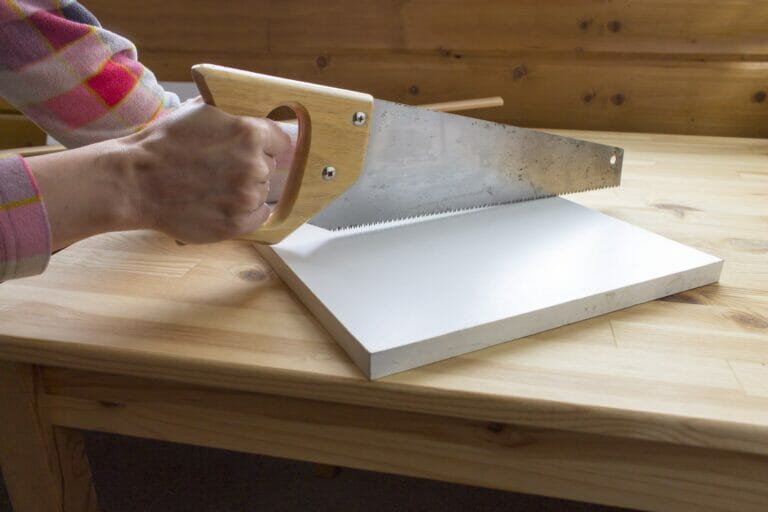
Can a hand saw cut through metal? It’s a question that may have crossed your mind if you’ve ever found yourself in need of cutting through metal and wondered if a hand saw could do the job. Well, you’re in the right place to find out!
When it comes to DIY projects or small metal-cutting tasks, a trusty hand saw can be a valuable tool to have in your arsenal. But can it handle the tough challenge of cutting through metal? Let’s explore this fascinating topic together.
Whether you’re a curious hobbyist or a budding DIY enthusiast, we’ll break down the possibilities and limitations of using a hand saw for cutting through metal. So, let’s dive in and discover if a hand saw is up to the task of tackling metal-cutting adventures!
Can a Hand Saw Cut Through Metal?
A hand saw can cut through certain types of metal, but it may not be the most effective tool for the job. While hand saws are primarily designed for wood, with the right blade and technique, they can cut through thin metal sheets, pipes, or rods.
For thicker or harder metals, it’s best to use a power tool like a reciprocating saw or an angle grinder. Always prioritize safety and use appropriate protective gear when working with metal and power tools.
Using the Right Type of Hand Saw
When it comes to cutting metal with a hand saw, the key is to use the right type of saw. While a regular hand saw designed for cutting wood won’t be effective in cutting through metal, there are specialized hand saws available that are designed specifically for metal cutting.
One example is the hacksaw. Hacksaws have fine-toothed blades that are capable of cutting through various types of metal with precision. Another option is a reciprocating saw fitted with a metal-cutting blade. These power tools are handheld and mimic the action of a hand saw but with additional power and speed.
Benefits of Using Hand Saws for Metal Cutting
1. Portability: Hand saws are lightweight and portable, making them ideal for projects that require metal cutting on the go or in tight spaces where larger power tools may not be suitable.
2. Cost-effective: Hand saws are generally less expensive than power tools, making them a budget-friendly option for occasional metal cutting needs.
3. Versatility: Hand saws can be used for various metal cutting tasks, including cutting through pipes, bars, rods, and smaller metal sheets.
4. Quiet operation: Unlike power tools, hand saws operate quietly, which can be advantageous if noise is a concern in your work environment.
5. Ease of use: Hand saws are relatively easy to use, making them accessible even for beginners or those with limited experience in metalworking.
Limitations of Hand Saws for Metal Cutting
1. Cutting Speed: Hand saws are slower compared to power tools such as angle grinders or plasma cutters. If you have a large volume of metal to cut or time is a critical factor, a hand saw may not be the most efficient option.
2. Cutting Thickness: While hand saws can cut through various thicknesses of metal, they are generally better suited for thinner materials. Thick metal sheets or heavy-duty metal bars may require the use of larger power tools.
3. Physical Effort: Using a hand saw requires physical exertion and endurance, especially for longer or more challenging cutting tasks. It may not be suitable for individuals with limited strength or stamina.
Choosing the Right Blade
To maximize the effectiveness of a hand saw for metal cutting, selecting the right blade is crucial. Different blades have varying tooth configurations, ensuring optimal performance for specific types of metal. For softer metals like aluminum, a blade with more teeth per inch (TPI) will provide smoother cuts.
Harder metals like steel or iron require blades with fewer TPI for faster and more efficient cutting. Be sure to choose a blade that is compatible with your specific hand saw’s blade attachment mechanism.
Tips for Using a Hand Saw for Metal Cutting
1. Prepare the work area: Clear the area of any obstructions and make sure the metal piece is securely clamped or held in place to prevent movement during cutting.
2. Use a cutting lubricant: Applying a lubricant to the blade will help reduce friction and heat, prolonging the lifespan of the blade and ensuring smoother cuts.
3. Start with a pilot hole: For greater control and accuracy, begin by drilling a small pilot hole at the desired cut location. This will guide the saw blade and make the cutting process easier.
4. Maintain steady pressure: Apply consistent, steady pressure throughout the cutting process, allowing the saw blade to do the work. Avoid forcing the saw or applying excessive pressure, as this can lead to blade damage or breakage.
5. Use proper safety equipment: Always wear appropriate safety gear, including safety glasses, gloves, and, if necessary, a face shield or respirator to protect against metal shards, sparks, and dust.
Considerations for Metal Types
Different metals have different properties, and some may be more challenging to cut with a hand saw than others. Here are a few considerations for specific metals:
Cutting Steel:
– Steel is a common metal used in various applications, and cutting it with a hand saw is possible. However, thicker steel may require a powered solution or specialized equipment like a plasma cutter.
Cutting Aluminum:
– Aluminum is softer than steel and can be cut with a hand saw more easily. Choose a blade with more teeth for smoother cuts.
Cutting Copper:
– Copper is a relatively soft metal and can be cut with a hand saw effectively. It is important to use a blade designed for metal cutting to ensure clean cuts without damaging the material.
A hand saw can cut through metal, but its effectiveness will depend on the type of saw and the specific metal being cut. Specialized hand saws designed for metal cutting, such as hacksaws or reciprocating saws with metal-cutting blades, are your best bet.
While hand saws offer portability, cost-effectiveness, and versatility, they may not be suitable for large or thick metal-cutting tasks. It’s important to choose the right blade for your hand saw based on the type of metal you’re working with, and always follow proper safety precautions. With the right tools, technique, and patience, a hand saw can be a practical solution for many metal-cutting projects.
Frequently Asked Questions
Welcome to our FAQ section where we address your burning questions about cutting through metal with a hand saw!
How can I cut through metal with a hand saw?
Cutting through metal with a hand saw requires the right technique and the right saw blade. To start, choose a saw blade specifically designed for metal cutting, such as a fine-toothed hacksaw blade or a bi-metal blade. Make sure the blade is securely attached to the saw.
Next, mark the area you want to cut and secure the metal firmly in place. Apply a lubricant like cutting oil to reduce friction and improve the cutting process. Begin cutting, using steady and even strokes. Take breaks to let the saw cool down if necessary. And remember, patience is key!
What type of hand saw is best for cutting metal?
The type of hand saw you use for cutting metal will depend on the thickness and type of metal you’re working with. For thinner metals, a fine-toothed hacksaw with a high TPI (teeth per inch) is typically a good choice. It allows for more control and precision.
However, if you’re working with thicker and harder metals, a bi-metal blade is highly recommended. Bi-metal blades are made from two different types of steel, combining flexibility and durability. They can withstand the toughness of metal and provide smoother cuts.
Can I use any hand saw to cut through metal?
While some hand saws are capable of cutting through metal, not all saws are designed for this purpose. It’s important to use a hand saw specifically designed for metal cutting to ensure a safer and more effective cutting experience.
Using a regular wood saw or a saw with the wrong type of teeth can result in a frustrating and potentially dangerous process, as well as damage to the saw. Always consult the manufacturer’s recommendations and choose the appropriate hand saw for metal-cutting tasks.
What safety measures should I take when cutting through metal with a hand saw?
When cutting through metal with a hand saw, it’s crucial to prioritize safety. Wear protective gloves to shield your hands from potential cuts or metal shavings. Safety goggles are also essential to protect your eyes from flying debris.
Additionally, consider using a clamp or vise to secure the metal in place, reducing the risk of slips and accidents. Take breaks as needed to avoid overheating the saw and always follow the proper technique to maintain control and minimize accidents.
What are the limitations of using a hand saw to cut through metal?
While hand saws can be effective in cutting through metal, there are certain limitations to keep in mind. Hand saws are best suited for thinner metals rather than thick or heavy-duty materials.
For thicker metals or materials such as steel or cast iron, using power tools like an angle grinder or a reciprocating saw may be more efficient. Hand saws also require physical effort and may not be as fast as power tools for larger cutting projects.
So, can a hand saw cut through metal? The answer is yes, but it depends on the type of metal and the type of saw. A hacksaw with the right blade can cut through thin metal, but for thicker metal, you’ll need a power saw like a reciprocating saw or an angle grinder. Always remember to take safety precautions and wear protective gear when working with metal.
In conclusion, while hand saws can cut through metal, it’s important to choose the right type of saw and blade for the job. Now you know that not all hand saws are created equal, and with the right tools and care, you can tackle metal cutting projects successfully.



